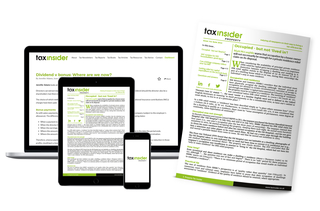New articles published
in March 2025
-
‘Settled’ on a house?
Principal private residence (PPR) relief is probably the most well-known and commonly used capital gains tax (CGT) relief. In many cases, it exempts a gain on an individual’s disposal of a dwelling house which is an only or main residence.
Mark McLaughlin looks at capital gains tax principal private residence relief when a house is held in a trust for a beneficiary to occupy.
-
Selling a property at a reduced value
There are various reasons why an owner sells a property at less than its market value. However, doing so can have serious tax implications, depending on the circumstances and the relationship between the buyer and seller, particularly if the sale is made to a family member.
Jennifer Adams outlines tax implications associated with the selling of a property below its market value.
-
CGT is not an option!
In my article last month (‘Absence of evidence is NOT evidence of absence’), I looked at an interesting case, Raveendran v HMRC [2024] UKFTT 00273 (TC), which helped a family demonstrate that funds provided by a sibling amounted to a loan, rather than a beneficial (CGT-able) interest in the property. Notably, this was despite HMRC’s complaint that the brother was unable to provide contemporaneous evidence that he did not own the property – which could be seen as something of a challenge, even at the best of times.
Lee Sharpe looks at a recent tax case that considered whether an option to buy something was actually an option or perhaps more importantly, when there was a choice.
-
Reporting residential property gains and tax payments
Not all residential property is equal when it comes to the tax treatment of capital gains.
Sarah Bradford explains when and how it is necessary to report a gain on the disposal of a residential property and pay the associated tax.
-
Q&As with Arthur Weller
Some of our most popular articles
-
Joint property letting vs partnerships
Property partnerships seem popular these days – typically, as a stepping-stone to greater things. Regular readers will know that I have long criticised HMRC’s published position on whether a property partnership exists, as distinct from simply co-owned property. My argument is that HMRC has drawn up its guidance to set an unreasonably high threshold to ‘make the grade’ as a partnership.
Lee Sharpe looks at whether a joint property letting activity amounts to a partnership, and why it is relevant to landlords.
-
Main residence relief and multiple residences
Most people do not expect to have to pay capital gains tax (CGT) when they sell their home. Private residence relief (also known as main residence relief or principal private residence relief) normally applies in full when the property has been the taxpayer’s only or main residence throughout the whole period for which they have owned it.
Sarah Bradford outlines the concept of a ‘main’ residence for capital gains tax purposes.
-
That old boiler: Repairs or improvement?
The government (HMRC) has become increasingly worried about the volume of small and medium-sized enterprise research and development (R&D) tax credit payments where a company claims to have undertaken eligible R&D activity (and it is important to keep in mind that only certain types of R&D may qualify – there are a lot of criteria).
Lee Sharpe looks at tax aspects of modernising property and the risk of disallowance as improvements that constitute capital expenditure, losing income tax relief in the property business.
-
Investing in commercial property: Tax implications
Whether to buy commercial or residential property depends on various factors, not least the more beneficial tax system for commercial lets and whether an individual or a company is purchasing the property. The government wishes to encourage commercial lets and therefore permits a more generous tax regime than residential lettings.
Jennifer Adams considers some important tax benefits of investing in commercial property.
-
Q&As with Arthur Weller
Subscription Benefits
We asked our subscribers what they love about Property Tax Insider.
These are the top 7 reasons that they gave us:
Monthly Newsletter
Property Tax Insider…





